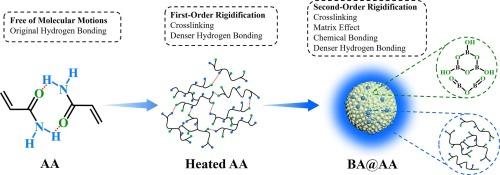通过逐步硬化调节丙烯酰胺的室温磷光,以检测薯片中的丙烯酰胺。
IF 4.3
2区 化学
Q1 SPECTROSCOPY
Spectrochimica Acta Part A: Molecular and Biomolecular Spectroscopy
Pub Date : 2024-11-01
DOI:10.1016/j.saa.2024.125372
引用次数: 0
摘要
丙烯酰胺(AA)的选择性检测至关重要,但这一检测受到高背景和食品基质干扰的限制。通过分步硬化策略调节室温磷光(RTP),开发出了一种室温磷光(RTP)检测方法。第一步刚性化导致 AA 交联,氢键更密集。这促使 RTP 效率从本文章由计算机程序翻译,如有差异,请以英文原文为准。

Modulating room temperature phosphorescence of acrylamide by stepwise rigidification for its detection in potato crisps
The selective detection of acrylamide (AA) is crucial, which is limited by the high background and interferences from food matrix. A room temperature phosphorescence (RTP) assay was developed through modulating its RTP by a stepwise rigidification strategy. The first step rigidification resulted in crosslinking of AA and denser of hydrogen bonding. This prompted the RTP efficiency from <0.1 to 3.8 % and emission lifetime of AA (from 3.0 μs to 0.29 s). Introducing boric acid resulted in the second step rigidification, triggered the formation of rigid matrix and chemical bonding. These synergistic effects prompted the photoluminescence quantum yield to 23.7 % and emission lifetime to 1.20 s. AA was quantitatively detected through monitoring the RTP intensity, with a limit of detection of 0.9 μg/mL. Benefiting from the delayed signal detection, background signal and the interferences from food matrices were eliminated, endowing the detection of AA in practical food samples.
求助全文
通过发布文献求助,成功后即可免费获取论文全文。
去求助
来源期刊
CiteScore
8.40
自引率
11.40%
发文量
1364
审稿时长
40 days
期刊介绍:
Spectrochimica Acta, Part A: Molecular and Biomolecular Spectroscopy (SAA) is an interdisciplinary journal which spans from basic to applied aspects of optical spectroscopy in chemistry, medicine, biology, and materials science.
The journal publishes original scientific papers that feature high-quality spectroscopic data and analysis. From the broad range of optical spectroscopies, the emphasis is on electronic, vibrational or rotational spectra of molecules, rather than on spectroscopy based on magnetic moments.
Criteria for publication in SAA are novelty, uniqueness, and outstanding quality. Routine applications of spectroscopic techniques and computational methods are not appropriate.
Topics of particular interest of Spectrochimica Acta Part A include, but are not limited to:
Spectroscopy and dynamics of bioanalytical, biomedical, environmental, and atmospheric sciences,
Novel experimental techniques or instrumentation for molecular spectroscopy,
Novel theoretical and computational methods,
Novel applications in photochemistry and photobiology,
Novel interpretational approaches as well as advances in data analysis based on electronic or vibrational spectroscopy.

 求助内容:
求助内容: 应助结果提醒方式:
应助结果提醒方式:


